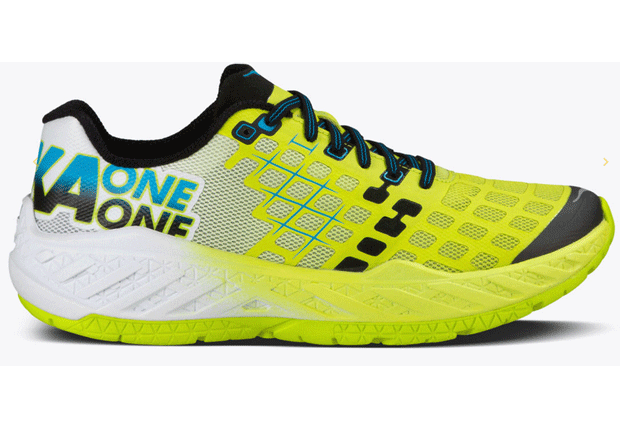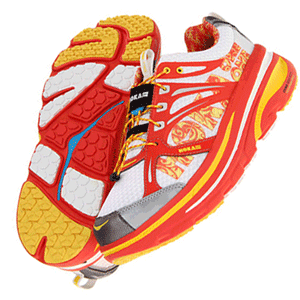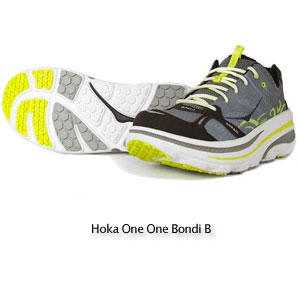“You make a triathlon shoe.”
“No, I don't,” said Hoka One One co-founder Nicholas Mermoud. “I make an ultradistance trail shoe.”
“Yes, but you also make a shoe for triathlon,” I responded to Mr. Mermoud. “and once you convert all the sky runners and you want to sell more shoes, you make a shoe that meets the needs of far more runners than you realize.”
This conversation took place was in late 2010, when Mr. Mermoud's footwear line consisted of one model, the Mafate, which was obviously built to be a trail shoe. But there is a nexus of needs between ultrarunners and triathletes; what works for one often works for the other. What the founders of this brand, Messers Mermoud and Jean-Luc Diard, had with that original Hoka was different and special.

There's an irony, considering the founders' adamant intention to make an offroad shoe, that Hoka was just announced the official shoe of the Ironman North American series. Ironic, but to me the natural evolution of this brand.
A few short months after this conversation Hoka One One manufactured its second model, the Bondi B. This was its first road shoe, which quickly became my go-to shoe for everything: road and offroad, training and racing. This shoe was so different and (for me) ahead of anything ever made by a footwear company that although it was not perfect, and not optimized for every style of running, it was better than every shoe I owned for every reason I owned it.
It is now 2016 and well more than 5 years since I laced up my first pair. A lot has changed. The founders sold their brands to Deckers Corporation, makers of Ugg Australia, Teva and others brands. I wrote at the time that this maker of “fashion” shoes was not simply making a strategic buy; from the CEO down Deckers is run by people who not only broke 40 minutes for 10 kilometers; in their day they broke 30 minutes.
The new owners understood the brand, and its theme, and its features beyond simply maximalism, and they remain attached (mostly) to the themes that underpin this brand.
There are now so many Hoka models I don't know them all. They've made shoes I like better than the Bondi, and I'd wear Hoka's 5th-best shoe before any other brand's best shoe because all other companies have borrowed, but not flat-out stolen, Hokas themes.
This brand has its detractors and you'll find them on our Reader Forum. Some of the complaints are silly. Some are not. Even Hoka fans have complaints. The brand has grown so fast amid changing ownership, factories, product managers, that it's no wonder that there have been snafus in sizing and in the desired versus actual ride of a shoe because a choice in midsole material. Welcome to technical running. Welcome to a 9-figure annual turnover achieved in one-fifth or one-tenth the time it takes most tech footwear companies to get there.

If triathletes were early adopters of Hoka, Slowtwitchers were the double-early adopters. Look at the adoption rate of this brand by Slowtwitchers in 3 short years. This was not paralleled in the shoe counts in Kona or other events. Slowtwitchers were on the leading edge in the use of this shoe brand and pulled the rest of the sport along with it.
This weekend racers will contest the Oceanside 70.3 and I'll eat my hat if Hoka is not the most-often used shoe at this race.
But does this new deal with Ironman make sense for Hoka? The official shoe designation was a disastrous hole down which K-Swiss dumped barrelfuls of money. The shoes were not by any means bad, but all the athlete sponsorships and the Ironman deal could not get this brand above 5 percent market share among triathletes.
Newton had the double advantage of an official Ironman designation and a couple of wins in the men's field at the World Championships in Kona. Newton did grab market share but in our polls of Slowtwitchers the brand crested at about 10 or 11 percent.
I can't find any evidence that the Ironman designation has ever helped a footwear brand in triathlon. Why would it help Hoka?
One reason: Access to a large number of athletes who can be impressed by the feel of a shoe during a demo. Hoka shines at demos. Nothing feels like a Hoka when you put it on and run in it, and no shoe is so different from a previous footwear experience.
Hoka the brand is run by people weaned as field service reps (FSRs) and they are all-in on the immersive experience of the field trials. This is why, when Deckers bought this brand, it built a nationwide network of FSRs before it built a network of sales reps.
Hoka's FSRs, if unleashed at Ironman expos, will cut a swathe like Patton's Third Army. I have not spoken to Deckers about this deal, so I don't know what they have in mind. Just, for this brand, as the proof of the pudding is in eating, the proof of the Hoka is in the running.


